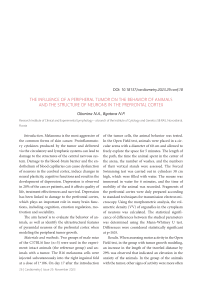The influence of a peripheral tumor on the behavior of animals and the structure of neurons in the prefrontal cortex
Автор: Obanina N.A., Bgatova N.P.
Журнал: Cardiometry @cardiometry
Рубрика: Conference proceedings
Статья в выпуске: 29, 2023 года.
Бесплатный доступ
Melanoma is the most aggressive of the common forms of skin cancer. Proinflammatory cytokines produced by the tumor and delivered via the circulatory and lymphatic systems can lead to damage to the structures of the central nervous system. Damage to the blood-brain barrier and the endothelium of blood capillaries can cause dysfunction of neurons in the cerebral cortex, induce changes in neural plasticity, cognitive functions and result in the development of depression. Depression is observed in 20% of the cancer patients, and it affects quality of life, treatment effectiveness and survival. Depression has been linked to damage to the prefrontal cortex, which plays an important role in many brain functions, including cognition, emotion regulation, motivation and sociability.
B16 melanoma, depressive-like behavior, neuronal ultrastructure
Короткий адрес: https://sciup.org/148327390
IDR: 148327390 | DOI: 10.18137/cardiometry.2023.29.conf.18
Текст статьи The influence of a peripheral tumor on the behavior of animals and the structure of neurons in the prefrontal cortex
Research Institute of Clinical and Experimental Lymphology – a branch of the Institute of Cytology and Genetics SB RAS, Novosibirsk, Russia
Introduction . Melanoma is the most aggressive of the common forms of skin cancer. Proinflammato-ry cytokines produced by the tumor and delivered via the circulatory and lymphatic systems can lead to damage to the structures of the central nervous system. Damage to the blood-brain barrier and the endothelium of blood capillaries can cause dysfunction of neurons in the cerebral cortex, induce changes in neural plasticity, cognitive functions and result in the development of depression. Depression is observed in 20% of the cancer patients, and it affects quality of life, treatment effectiveness and survival. Depression has been linked to damage to the prefrontal cortex, which plays an important role in many brain functions, including cognition, emotion regulation, motivation and sociability.
The aim hereof is to evaluate the behavior of animals, as well as identify the ultrastructural features of pyramidal neurons of the prefrontal cortex when modeling the peripheral tumor growth.
Materials and methods . Two groups of male mice of the C57BL/6 line (n=5) were used in the experiment: intact animals (the reference group) and animals with a tumor. The B16 melanoma cells were injected subcutaneously into the right inguinal fold at a dose of 1*106. On day 17 after the introduction 26 | Cardiometry | Issue 29. November 2023
of the tumor cells, the animal behavior was tested. In the Open Field test, animals were placed in a circular arena with a diameter of 60 cm and allowed to freely explore the space for 5 minutes. The length of the path, the time the animal spent in the center of the arena, the number of washes, and the numbers of their vertical stands were assessed. The Forced Swimming test was carried out in cylinders 30 cm high, which were filled with water. The mouse was immersed in water for 6 minutes, and the time of mobility of the animal was recorded. Fragments of the prefrontal cortex were duly prepared according to standard techniques for transmission electron microscopy. Using the morphometric analysis, the volumetric density (VV) of organelles in the cytoplasm of neurons was calculated. The statistical significance of differences between the studied parameters was determined using the Mann-Whitney U test. Differences were considered statistically significant at p<0.05.
Results. When assessing motor activity in the Open Field test, in the group with tumor growth modeling, an increase in the length of the traveled distance by 29% was observed that indicated an elevation in the anxiety of the animals. In the group of the animals with the tumor, other signs of activity were more often noted: the animals jumped and clung to the edge of the arena. In the Forced Swimming test, the mobility time of animals in the group with the tumor growth decreased by 16%. A reduction in the mobility time in this test indicates the development of depressive-like behavior.
When analyzing the ultrastructure of the pyramidal neurons of the prefrontal cortex in the animals with the peripheral tumor, a 3.43-fold increase in the volumetric density of mitochondria with destructive changes in the cristae was observed that amounted to 47.6% of the total number of mitochondria in that group. An expansion of the lumens of the endoplasmic reticulum (ER) cisterns was observed, the volumetric density of which was 3.25 times higher than the indicator in question in the reference group. The volumetric density of free polysomal complexes has decreased by 74%.
Conclusion . The study suggests that the animals with the peripheral tumor growth develop anxiety-depressive behavior. At the same time, in the neurons of the prefrontal cortex of the brain there are an increase in mitochondria with destructive changes, an expansion of the lumen in the ER cisterns and a decrease in the number of polysomal ribosomal complexes that may indicate a reduction in the energy function of the cell, the development of ER stress and disruption of protein synthesis and folding.


